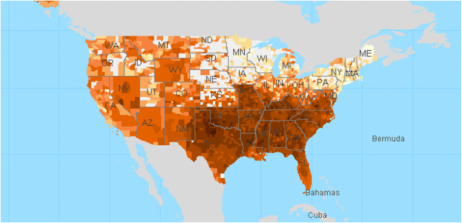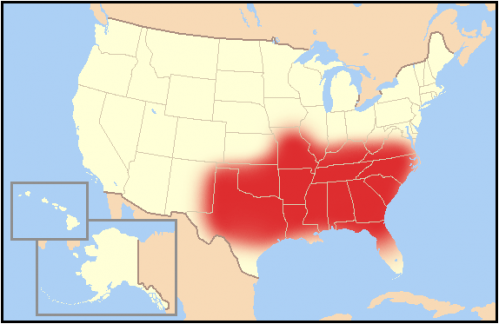In Peacock’s book, he describes a scene of a minister acting out the religious proverb “Man shall not live by bread alone” until it was guess by a member of the crowd followed by an invitation to come to the game (146). This depiction shows clearly the assumption in the south of common experience based on religion and in general how it is assumed to be a common identity for all. Though scholars argue back and forth about how big of a role religion plays in the South and whether it is experiencing secularization on the level of the rest of the country, one thing is clear—religion plays a role in southern life. Religious identity is expressed through the fact that the southern style of religion is unique, has held a particular importance in the region for some time, it is expressed politically and socially, it has shaped the physical landscapes of towns and cities.
Religion has been important in the US since its days of Puritan colonies, but religion in the South took on its own unique style and path. Clark believes that the church came to symbolize Southern life after losing the Civil War. He states that the south was a place of captive people and religion is particularly important to captive peoples. For white southerners the church was basically the only thing they could control during reconstruction (214). The church gave white southerners an “institution to deal with their emotional and social needs” (Clark, 215). The church also holds serious importance in black southerners’ lives, so the same captive argument can be used for black southern churches (Clark, 215). The south felt alienated before and after the war. The feeling of alienation also contributed to the south to forming a “fundamentally different style of religion” and for that style to domination in the region up until the present (Clark, 213).
Southern religion is unique. “Southern-style religion is emotional, Jesus-centered form of Protestantism involving a ‘born-again’ experience, the literal interpretation of the Bible, and a strict moral code for behavior. In other words, Southern-style religion is essentially evangelical in character” (Shibley, 163). This style of religion is shaped after and also shapes the cultural and social values of Southern life. Religious identity in the south is one that is shared across racial and ideological lines. That is why candidates who adequately tap into this identity can get voters to vote for them as long as they stress conservative ideas openly and frequently enough.
One aspect of the Bible belt region is that religious leaders are in power or at least influence power politics. From the political connections of television and radio evangelist Billy Graham, to the Moral majority, to the New Christian Right, Protestant Evangelists have been able to influence politics on the local and national scale. Their tactics include “organizing a well-financed, grass-roots campaign to influence electoral politics on behalf of conservative Christian causes” (Shibley, 160). The push to get conservative causes can be seen in recent political news with the focus on abortion and attempts to define marriage as between a man and a woman. The conservative element of the religion that also flows through the society forces Democrats in the south to separate themselves somewhat from the national party and play up personal values like supporting capital punishment and NRA endorsements (Gilgoff). For conservative religious leaders in power personal and religious stances are important in an election. The candidates that can blur the separation of church and state fair the best in the ‘bible belt.’
The significance of religion in the region is obvious in the landscape of towns and cities. Peacock states that protestant evangelical “churches, with some exceptions, are in the centers of southern towns and cities still, whose seminaries and universities are most recognized, and whose members are most affluent and influential” (142). Have religious buildings being in the center and having seminaries and universities prominent, is a strong but subtle display of how religion is viewed. Everything radiates out from the center of town with the center being where everything comes together. A church in the center is a statement of religiousness. “The South is indeed a ‘Christ-haunted landscape” (Peacock, 143). The churches may not dominate the landscape per say, but they are in important locations within the landscape.
The new question is if religion can maintain a strong hold in the south and keep its unique attributes as the South becomes more integrated with not only the US but the rest of the world. With such a deep history in the South it seems unlikely that the region will give way to major secularization anytime soon. Religion in the South is an important identity. Attending church and being familiar with scriptures and proverbs like the one mentioned in the introduction is the assumption based on the fact that religion influence is so obvious in the south it is somewhat hard for people to imagine someone to not be involved. The preponderance and central location of churches, the blatant mixing of conservative Christian values and politics will most likely continue for while to come.


